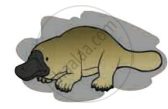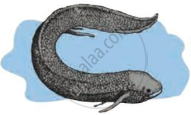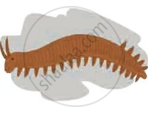Advertisements
Advertisements
प्रश्न
Write the answers to the questions by observing the figure below.
 |
 |
 |
| (a) | (b) | (c) |
- Write the name of the animal ‘(a)’ in the figure.
- Write the name of the animal ‘(b)’ in the figure.
- Write the name of the animal ‘(c)’ in the figure.
- Which evolutionary evidence is illustrated by this figure?
- Write the definition of that evidence for evolution.
उत्तर
- ‘(a)’ - Duck billed platypus
- ‘(b)’ - Lungfish
- ‘(c)’ - Peripatus
- The evolutionary evidence illustrated in the given figure is connecting links.
- Definition: Connecting links are some plants or animals that show morphological characters by which they can be related to two different groups of organisms.
संबंधित प्रश्न
Mammals : _________ : : Amphibia : Fishes
What are vestigial organs?
(a) Select the homologous structures from the combinations given below:
(i) Forelimbs of whales and bats
(ii) Tuber of potato and sweet potato
(iii) Eyes of octopus and mammals
(iv) Thorns of Bougainvillea and tendrils of Cucurbita
(b) State the kind of evolution they represent.
“Two areas of study namely 'evolution' and 'classification' are interlinked'. Justify this statement.
If you are asked to select a group of two vegetables, out of the following, having homologous structures which one would you select?
(a) Carrot and radish
(b) Potato and sweet potato
(c) Potato and tomato
(d) Lady finger and potato
Select two pairs from the following which exhibit divergent evolution. Give reasons for your answer.
(i) Forelimbs of cheetah and mammals
(ii) Flippers of dolphins and penguins
(iii) Wings of butterflies and birds
(iv) Forelimbs of whales and mammals
Four students A, B, C and D reported the following set of organs to be homologous. Who is correct ?
(A) Wings of a bat and a butterfly
(B) Wings of a pigeon and a bat
(C) Wings of a pigeon and a butterfly
(D) Forelimbs of cow, a duck and a lizard
Find out from newspapers and popular science articles any new fossil discoveries or controversies about evolution.
Explain with an example for the given, how the following provides evidence in favor of evolution in organisms :
Analogous organs
Explain with an example for the given, how the following provides evidence in favor of evolution in organisms :
Fossils
Differentiate between analogous and homologous structures.
The forelimbs of a frog, a bird and a man show the same basic design (or basic structure) of bones. What name is given to such organs?
The organs which perform similar functions but have different basic structure are called :
(a) asymmetric organs
(b) analogous organs
(c) homologous organs
(d) homophonic organs
Some dinosaurs had feathers although they could not fly birds have feathers that help them to fly. In the context of evolution, this means that ______
Select a set of homologous organs from the following:
(A) Wings of a bat and wings of a butterfly
(B) Wings of a pigeon and wings of a bat
(C) Wings of a butterfly and wings of a pigeon
(D) Forelimbs of a duck, forelimbs of a cow and forelimbs of a lizard
Write short notes based upon the information known to you.
Embryology
The most common types of fossils are ------------------------.
Draw a labelled diagram of T.S. of a leaf showing Kranz anatomy.
Explain any three molecular (genetic) evidences in favour of organic evolution.
Similarities in the initial stages indicate the _______ evidence.
Find an odd one out.
Name the parts shown in the diagram.
Human jaw

Complete the flowchart.

Select the CORRECT set of homologous organs.
The fossil remains of Archaeopteryx is a connecting link between ______
Why do all the gametes formed in human females have an X chromosome?
Homologous organs are:
Basic principles of embryonic development were pronounced by:
Evolutionary convergence is the development of:
The presence of gill slits, in the embryos of all vertebrates, supports the theory of ______.
Animal husbandry and plant breeding programmes are the examples of ______.
How do we compute the age of a rock?
Complete the following chart:

Define the term:
Homologous organs
Industrial melanism was highlighted by ______.
Give examples of homologous organs and analogous organs in plants.
Write names of some vestigial organs in the human body.
